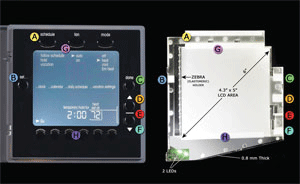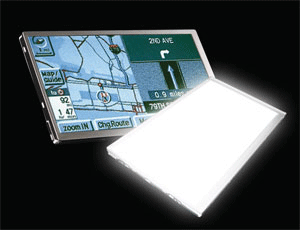Choosing an approach for lighting displays with LEDs
Moving from traditional backlighting to edge-lighting can provide higher brightness with fewer LEDs in a thinner unit
BY DAVID DeAGAZIO
Global Lighting Technologies
Brecksville, OH
http://www.glthome.com
It is not news that LED are becoming is increasingly more popular than cold-cathode fluorescent lamps, or CCFLs, for display backlighting. For many years, LEDs have been the light source of choice in smaller-form-factor displays in sizes of 3.5-in. diagonal or less, such as those used in cell phones, PDAs, MP3 players, digital cameras, and other handheld electronics.
But now LEDs are making inroads into mid-size (3.5 to 7-in. diagonal) and even the larger LCDs used in notebook computers and flat-panel TVs (to sizes 50 in. diagonal and above). LED backlighting provides a wider color gamut, longer life, inverterless dc power, lower power consumption, greater design flexibility, a smaller form factor, and lower cost. Further, its mercury-free construction and longevity make it more environmentally friendly. New approaches such as edge-lighting (see Fig. 1 ) are amplifying these benefits.

Fig. 1. For a thermostat (left), an edge-lit MicroLens light guide (right) illuminates nine discrete areas: main LCD area, characters and directional symbols at the top and sides (A through F) and keypad buttons with “halo” effect at top and bottom (G and H).
New applications
Notebook computers are already switching from CCFL backlights to edge-lighting with white phosphor LEDs. For this application, a blue LED is imbued with an amber phosphor to convert the visible wavelength to white. The white LEDs still deliver a percentage of the color spectrum comparable to CCFL (approximately 75% compared to 70% to 80% for the CCFL) while providing lower power consumption.
RGB LED-based backlight modules are made using advanced RGB LED backlight unitseach containing three chips with separate red, green, and blue dieplaced closely together in a single package. RGB LEDs offer color saturation above 100% NTSC (~110%), exceeding the 70% NTSC color gamut standards for conventional CCFL backlight modules and allowing unprecedented high-resolution performance.
For desktop monitors in many applications, such as advertising, television production, publishing, and industrial design, RGB LEDs are ideal because they can deliver exceptional color accuracy. In addition to providing truer color, today’s high-efficiency edge-lit light guides can disperse the light from a single LED over a much wider area.
Another important characteristic to consider when choosing a lighting approach is lifetime, or time to half brightness. For a CCFL, the time to half brightness is an average of 5,000 hours, although the lamp may continue to glow for as much as another 15,000 hours. In addition, the CCFL will also begin to get dark at its ends, adversely affecting backlight uniformity.
White phosphor LEDs can offer 20,000-30,000 hours to half brightness, after which a problem may occur with phosphor degradation. RBG LEDs can offer 50,000 hours time to half brightness (blue and green) and 100,000 hours (red).
LED backlighting techniques
For mid-size (3.5 to 7-in. diagonal) LCDs, designers are confronted with a choice of different LED backlighting technologies.
As with all LED backlighting options, the direct method eliminates noise and the need for an inverter—which allows the device to run directly from batteriesand provides more design flexibility. It employs top-firing, surface-mounted, non-focused (120° viewing angle) LEDs.
With this approach, the brightness is good, but, since there is little or no way for this technique to channel the light uniformly, designers need a lot of LEDs to achieve good uniformity. Cost, heat, power, thickness, and PCB real-estate become key issues because of the number of LEDs .
LED arrays are another direct illumination technique. They are very high in brightness and typically consist of a matrix of LED chips mounted in a white plastic frame on the PC board inside an LCD. However, for an LCD with a viewing area of, say, 0.62 x 2.5-in., as many as 36 LED chips may be needed. LED arrays tend to run hot, and are viable only for small backlights in less expensive colors like yellow-green. Available white LED arrays are expensive.
Another approach is edge-lit LED backlighting. Edge lighting employs side-firing LEDs that focus the light into a high-performance light guide. There are several edge-lighting light-extraction technologies: printed, etched (using chemical, laser, or other means), stamped V-groove, and pixel-based (see table ).
Comparison of edge-lighting methodologies
| Technology | Efficiency | 2D pattern possible |
| Printed dots | low | yes |
| Etched dots | good | yes |
| V-grooves | very good | no |
| Pixel-based | very good | yes |
Since the LEDs are located on the edge of the light guide, the approach offers benefits that include:
Better optical control, especially of color and uniformityFewer light-management film layersFewer LEDsBetter repeatability at all levelsReduced power consumptionThinness as low as 0.34 mm.
One example of this approach uses a pixel-based based light extraction technique called MicroLensa light guide technology with light extraction features directly molded into it. This pixel-based light extraction technology is used with advanced high-bright white LEDs.
The approach provides enhanced brightness (to 15,000 cd/m2 and above), crisp color, extreme thinness (0.5 mm and below), less power consumption, and a smaller form factor with fewer components. It also generates a very tight color consistency.
Edge-lit backlighting allows for color mixing within the light-guide. This not only eliminates the LED-to-LED deviations which can be evident in the direct lighting approach, but also makes edge-lit guides very adaptable to multi-function displays like that in fig. 1. The molded light guide technology makes highly efficient use of white LEDs, so designers can use fewer LEDs and reduce costs.
RGB LED edge-lighting
Edge lighting with white phosphor and RGB LEDs is proving to be a viable solution for higher-end applications. Edge-lighting is generally preferred over direct LED backlighting, as the edge-lit displays in popular cell phones and notebook computers bear witness. Edge-lighting technology is also being used to provide durable, uniform, high-brightness illumination for medium-size TFT LCDs, such as the 7-in. displays used in portable DVD players and automotive GPS systems, that have traditionally used CCFLs.

Fig. 2. This 7-in. GPS display uses LED edge lighting rather than CCFL.
Until recently, light guides have not had sufficient brightness and efficiency to illuminate large-screen TVs and high-definition displays. But the use of MicroLens light guides in combination with the PhlatLight (“Phlat” refers to photonic lattice) chipsets developed by Luminus Devices (Billerica, MA) have enabled the development of an efficient, cost-effective edge-lighting technology for large-screen TVs with outstanding brightness and uniformity.
The PhlatLight ELU from Luminus and GLT uses only 10 RGB chipsets in a 52-in. LED backlight for LCD TVs, simplifying color management and enabling advanced features such as local dimming. Each PhlatLight chipset, containing a single red, green, and blue LED, delivers an extremely high surface brightness with uniform light output. “Lens Arrays” located on the edge of the light guide serve spread light uniformly, while micro-optical elements efficiently extract light at each pixel. ■
For more on displays and LEDs, visit http://electronicproducts-com-develop.go-vip.net/opto.asp
Advertisement
Learn more about Global Lighting Technologies





